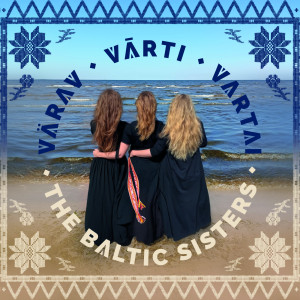 The Baltic Sisters’ single “Soka Saule Rītiedama” was one of my favorite songs on the Folk Galore label’s Folk and World Music Galore Vol. 3 compilation that dropped in late 2024, and I’m delighted to share the news that the album on which it is featured has now been released. The quartet’s debut album Värav • Vārti • Vartai on Folk Galore’s sister label CPL-Music is a mesmerizing collection of polyphonic folk songs from the Baltic states of Latvia, Estonia and Lithuania.
The Baltic Sisters’ single “Soka Saule Rītiedama” was one of my favorite songs on the Folk Galore label’s Folk and World Music Galore Vol. 3 compilation that dropped in late 2024, and I’m delighted to share the news that the album on which it is featured has now been released. The quartet’s debut album Värav • Vārti • Vartai on Folk Galore’s sister label CPL-Music is a mesmerizing collection of polyphonic folk songs from the Baltic states of Latvia, Estonia and Lithuania.
The Baltic Sisters are Marion Selgall (Estonia), Laurita Peleniūtė (Lithuania), and Vineta Romāne and Liene Skrebinska (Latvia). The album, whose title is The Gateway or The Portal in the three languages, blends the folk songs of the three countries, sometimes individually and sometimes interwoven as seamlessly as their vocals twine around each other. They met in 2022 at Womex in Lisbon and were brought together by their shared passion for the traditional Lithuanian polyphonic song style called Sutartinės.
On Vārti they go beyond that tradition, mixing, matching and blending the songs and styles of all three nations, sometimes literally. It’s a delicate dance, especially since Latvian and Lithuanian language are closely related, stemming from the Indo-European family, while Estonian is part of the family that includes Finnish and other Slavic tongues. Regardless, the three countries and their people feel a close kinship.
“We represent three nations on the Baltic Sea that have stood by each other in both turbulent and triumphant moments of history,” they say in their liner notes. “While distinct, we share much: a common past, a hard-won freedom, and a home by the sea. Our cultures are rich, and our languages ancient.”
For an example of the Sutartinės style, see this charming performance video from the 2024 Viljandi (Estonia) Folk Music Festival, where “Soka Saule Rītiedama” is sandwiched between two other songs from the album: “The Cuckoo Song” (which on the video is accompanied by a droning of a bowed Lithuanian zither called kokle) and “Tumsīnā, vakarā.” On the video they do a simple folk dance as they sing “Soka Saule Rītiedama,” which adds a visual element to the way the polyphonic vocal lines are intertwined.
So that’s a taste of what’s on this ambitious album. The musicians and production crew have wisely included a certain amount of variety to the program. Sadly, Liene Skrebinska’s kokle does not play as strong a role in “Cuckoo Song” on the album as in the video, but it does show up to good effect (in plucked mode) on the lullaby-like “Dai Kas Padunda.” The songs are an appealing mix of slower and quieter songs like this one, and more upbeat rhythmic fare like “Aja Kari Siia!” (Drive the herd over here!), and “Trepute Martela,” punctuated by foot percussion and handclaps. “Sviro Lingo” (Girls’ bench) employs a frame drum and some kind of drone, possibly the bowed kokle, as does the dramatic “Tumsīnā, vakarā” (in the dark evening).
Fans of women’s polyphonic music who are hitting the European festival circuit in 2025 should keep an eye out for The Baltic Sisters.
(CPL-Music, 2025)
